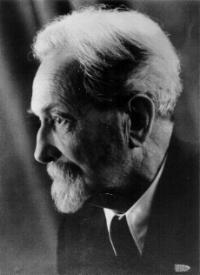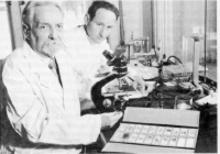Introducing Prof. Dr. Günther Enderlein
 Much of Sanum-Kehlbeck’s work is based on the pioneering and extensive research of the German microbiologist Prof. Dr. Günther Enderlein (1872–1968) whose main book Bacteria Cyclogeny was published in 1925. Enderlein was a visionary thinker who made profound discoveries about the nature of chronic disease during his 60 year career. He wrote over 500 scientific papers, was a journal editor, lectured internationally and founded the IBICA Institute for microbiological research into health.
Much of Sanum-Kehlbeck’s work is based on the pioneering and extensive research of the German microbiologist Prof. Dr. Günther Enderlein (1872–1968) whose main book Bacteria Cyclogeny was published in 1925. Enderlein was a visionary thinker who made profound discoveries about the nature of chronic disease during his 60 year career. He wrote over 500 scientific papers, was a journal editor, lectured internationally and founded the IBICA Institute for microbiological research into health.
Enderlein’s major contribution was the concept of pleomorphism, the idea that microbes assume numerous forms within a developmental cycle he termed cyclogeny. The phases of cyclogeny start from virus-sized particles, progressing to bacteria and then culminating a fungi. These microbial forms exist throughout the body and are symbiotic or pathogenic according to the conditions of the inner environment. By contrast, modern medicine is based on the monomorphistic view that microbes exist primarily in one form and mainly attack the body from the outside.
Enderlein observed human microflora by using live blood under a darkfield microscope which enabled him to identify various types of degeneration. He also discovered a natural bioregulatory process by which the inner microbial ecosystem maintains a healthy balance. He identified the regulators as ‘symbionts’ that restore ‘symbiotic equilibrium’, which for him represented an ideal state of health. From this insight, Enderlein developed his unique isopathic remedies derived from fungal cultures.
 Of particular significance for health are the life cycles of Mucor racemosus and Aspergillus niger, which he discovered to be fundamental to the microflora of all humans and mammals, along with Candida and species of Penicillium. In any such microbial life cycle, virulent forms can be returned to harmless avirulent forms with the corresponding fungal isopathic remedy. Sanum therapy also uses various potentised bacterial remedies, nutritional an herbal preparations to rebalance the ‘soil’ out of which diseases emerge. Most essential are the pH products needed to ‘alkalise’ the body. Many conditions are caused by over-acidity as this provides the milieu in which destructive microbes develop.
Of particular significance for health are the life cycles of Mucor racemosus and Aspergillus niger, which he discovered to be fundamental to the microflora of all humans and mammals, along with Candida and species of Penicillium. In any such microbial life cycle, virulent forms can be returned to harmless avirulent forms with the corresponding fungal isopathic remedy. Sanum therapy also uses various potentised bacterial remedies, nutritional an herbal preparations to rebalance the ‘soil’ out of which diseases emerge. Most essential are the pH products needed to ‘alkalise’ the body. Many conditions are caused by over-acidity as this provides the milieu in which destructive microbes develop.
Enderlein described disease primarily as a manifestation of the ‘endobiosis’ (the Mucor cycle), to which he saw similarities to the psora miasm as defined by Hahnemann. He also described the ‘paratuberculosis’ (the Aspergillus cycle) as another significant miasm underlying many chronic conditions. Most of the Sanum remedies work at this deep miasmatic level to increase overall constitutional health and vitality.
The history of the Sanum remedies
Enderlein became the production manager for the company Sanum. It was formed in 1932 by an employee of the Robert Koch Institute to manufacture bacterial remedies for immunobiological health. Enderlein’s close confidant for many decades, Mr. Heinrich Kehlbeck, bought Sanum with all its rights and trademarks in 1975. He merged with the IBICA Institute to create Sanum-Kehlbeck GmbH & Co. KG. Enderlein gave the Kehlbeck family exclusive custodianship of all his original microbial cultures, his specialised production knowledge, and sole rights to use his work. Sanum-Kehlbeck still retains the official registrations for these original products. All of Sanum’s products are produced at their excellent manufacturing facility to GMP standards and they comply with EU legislation.
Another range of products of historical significance is the Polysans, containing potentised colloids manufactured from the original mother tinctures of Dr. med. Carl Spengler (1860 – 1937), a noted Swiss researcher of tuberculosis and syphilis. The Polysan test helps to reveal insidious latent infections that need to be eliminated to enable deep regeneration.
